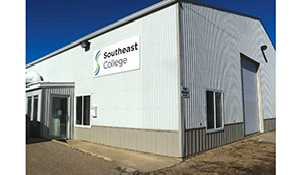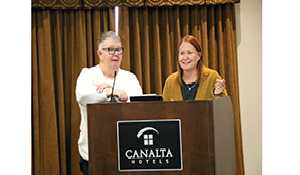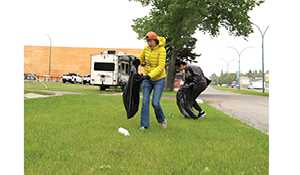Changes made to CEWS to help more businesses
July 27, 2020, 9:23 am
Rob Paul - Local Journalism Initiative Reporter


The Canadian Emergency Wage Subsidy (CEWS) was implemented by the federal government to help struggling businesses through the Covid-19 pandemic.
The federal government intended for the CEWS to help businesses pay employees as the pandemic impacted revenue. Originally the CEWS was put into place for a 12-week period from March 15 to June 6 with businesses being eligible for up to 75 per cent of employee wages. It was later extended another 12 weeks until August 29.
With the CEWS came much criticism over the lack of information on the process, the strict criteria for eligibility, and the timeframe businesses could access the CEWS.
On July 17, the federal government announced proposed changes to the CEWS with the intent to extend the program until December 19, though, the current program details have only been extended until November 21. The changes to the CEWS still need to pass through legislation to be enacted.
The new CEWS details will allow for more businesses to be eligible, according to Finance Minister Bill Morneau.
“We are ensuring that Canadians are able to get back to work as quickly as possible,” he said. “The adjustments we are proposing would ensure that the CEWS continues to address Canadians’ needs while also positioning them for growth as economies continue to gradually and safely reopen.”
Proposed changes for the CEWS from the government:
• Allow the extension of the CEWS until December 19, 2020, including redesigned program details until November 21, 2020.
• Make the subsidy accessible to a broader range of employers by including employers with a revenue decline of less than 30 per cent and providing a gradually decreasing base subsidy to all qualifying employers.
• Introduce a top-up subsidy of up to an additional 25 per cent for employers that have been most adversely affected by the pandemic.
• Provide certainty to employers that have already made business decisions for July and August by ensuring they would not receive a subsidy rate lower than they would have had under the previous rules.
• Address certain technical issues identified by stakeholders.
Throughout the Covid-19 pandemic, Canadian Federation of Independent Business (CFIB) has been asking the federal government to make the CEWS criteria more clear and change it to allow for more small businesses to be eligible.
“CFIB is pleased the government has finally released details of what the CEWS will look like for the summer and fall of this year. Assuming the legislation passes, small businesses will be able to make their staffing plans for the rest of the year with a better understanding of how much government support will be there, depending on their sales. Extending the subsidy and providing firm details are critical parts of getting Canadians back to work,” said CFIB President Dan Kelly.
Kelly said the previous “all or nothing” approach excluded many struggling businesses that were unable to predict their sales levels or had revenue losses under 30 per cent. Although CFIB is pleased the criteria for eligibility have been expanded to help more businesses and the program has been extended, they still have concerns around the rules of the CEWS.
“The new rules are incredibly complicated and small business owners will need significant help in understanding whether they will qualify and how much support they may receive,” he said.
“There are top-ups for those with revenue losses greater than 50 per cent and ‘safe harbour’ rules for those who would otherwise get a smaller subsidy in July and August. Over one-third of CFIB members report their sales are less than half of normal levels.
“Many of these decisions make good sense, but a detailed analysis is required to fully understand all of the implications,” he said. “CFIB is committed to working with the federal government to help communicate the new rules to small business owners and provide advice on any necessary changes.”
It’s taken a couple months, but CFIB Prairie Region Director Jonathan Alward says the CEWS program is on the right track to towards helping as many small businesses as possible.
“The reaction has been quite positive,” he said. “If you look at the previous CEWS program, it was really at a point where a business was either going to get it all, or just about nothing if your revenue reached 70 per cent of normal. I think this more graduated approach is going to be more fair to a lot of businesses. It also gives them a lot of predictability going into the fall.
“One part of the program that’s been a really welcome addition is the security it provides giving businesses a clear path forward into the late summer, fall, and early winter with the program now running until mid-December. I think this will give businesses a chance to actually plan accordingly to help their recovery in terms of investments and bringing staff back as they can.”
Having the program extended multiple months is major, says Alward, because with the short-term window for the CEWS previously it didn’t allow businesses to confidently plan ahead.
“It was originally only a three-month program and then they extended it until July and August,” he said. “But even up until the middle of last week—halfway through July—they hadn’t even provided the details about how the program would be changing.
“I think giving this several months of time for businesses to plan is going to be a very important addition to the program and hopefully we’ll see a lot of uptick continue going forward because people will have the confidence to know that it’s going to be there as they make those investments to bring staff back.”
Even though the federal government has made improvements to the CEWS program, Alward says, it remains hard to navigate and expects CFIB members to be seeking guidance.
“The biggest problem right now is how complicated it is,” he said.
“There’s so many different layers. There’s obviously the drop test that changes based on the period, which basically the periods go on a monthly basis and it drops depending on where your revenues are, but it also drops depending how far along in our economic recovery you are too. Meaning what you get in August, might not be what you’re going to get back in November even if your revenue drop is the same.
“On top of that, there’s the top-up provision if your business has been severely impacted and there’s also the safe harbour period for July and August for those businesses that had their revenues meet the at least 30 per cent drop, then they’ll be getting at least the 75 per cent wage subsidy for those first two months into the new phase.
“All that said, I have no doubt that there will be a lot of small businesses calling into CFIB or the federal government to get some clarity around those rules and what they mean for their business,” he said.
“We know that even in the simpler form, there was a huge amount of confusion and questioning that came as a result of how to calculate the drop, what happens if you’re at 29 per cent vs. 30 per cent, all of those kinds of things. So we’re certainly hoping the federal government will provide as much clarity as possible.
“With it being so complicated, we’re still combing through everything with a fine tooth to make sure that it is going to be the most fair plan for small businesses out there, but I do think as a whole it addresses a lot of the problems that we had raised in the previous two months.
“We’ve gotten a few calls just looking for more information on the program,” he said.
“I expect that as people have a chance to read through it and really digest it—it came out very late in the week so I expect that there will be some lag between when it came out and when people can really digest it—I expect we’ll be getting a lot of calls throughout the following weeks and we’ll be there to try and answer questions with our Business Help Line or via email.”
On top of giving guidance on the CEWS program, Alward says, CFIB will continue to get feedback on the situations Covid-19 has put small businesses in throughout Canada.
“That’s (giving guidance) certainly a big part of it for us,” he said. “The other thing though is we’re talking with business owners every single day, we’ve fielded over 45,000 calls regarding Covid-19, so all of this is in our wheelhouse, but we’re also surveying members every other week now. I expect we’ll be asking for feedback on this program and others, as we have been, and we’ll be taking those recommendations to the federal government.
“It’s really hard to get these programs right, especially when they’re being rolled in a very short amount of time. The federal government has been relatively responsive in the past few months to change this program in particular based on feedback we’ve provided to them. Hopefully that’s the case going forward.
“The other thing is, they’ve put the idea forward, but it still has to pass legislation.”
Assuring businesses owners fully understand the CEWS program is CFIB’s top objective, says Alward, because they want to make sure they’re confident in accessing it.
“It’s a big financial commitment to make because at the end of the day you’re still paying to bring your staff back and getting the money back after that period once you’ve applied for those hours,” he said. “It’s a commitment that you have to make with the financial risks that your business has to make. But what’s nice about it now too, is a lot of businesses are going to be more confident with this.
“I was talking to a friend in the restaurant sector where he’s bringing back dine-in and he wasn’t sure if he was going to be at that 30 per cent revenue drop for July. What this does now is it at least gives you some confidence, even if you don’t meet that criteria, that there will be at least some rebate back to help you cover those staffing costs. I think hopefully that will give business owners a lot more confidence to invest in the program.”
The CEWS program changes are a great step by the federal government, says Alward, but listening to feedback and making changes to other programs to help businesses through Covid-19 is a must.
“Absolutely (CFIB wants to see changes to other pandemic related programs),” he said. “One big one that’s been a very successful program too, along with the CEWS, is the Canada Emergency Business Account (CEBA). If you look at the Canada Emergency Commercial Rent Assistance program it’s really been plagued with significant problems. I think if the federal government wants to, and really need to, help a lot of businesses still that are struggling with cash flow problems they should be improving access to CEBA.
“Increasing the loan from much higher than the $40,000 that was originally provided and increasing the forgivable portion upwards of 50 per cent. I think those would be two very important steps.
“As well, they have recently expanded the CEBA program for the third time and we need to still make sure that businesses with personal accounts still have access to that original program. That would be another very important improvement that needs to be made, yesterday frankly.”
“They (giving guidance to small businesses and giving recommendations to the federal government) go really well hand in hand,” he said.
“From the start of the pandemic when they originally brought out the CEWS program at a 10 per cent wage subsidy to what it is now, it’s been a complete transformation, but that’s because we heard so many problems from our members through calls and surveys.
“We took that to the federal government and they fortunately listened, in most respects, and we’ll definitely continue to do that going forward.”




























SM.jpg)






